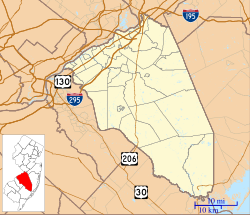Revell House | |
 | |
| Coordinates | 40°04′46″N74°51′41″W / 40.07954°N 74.86140°W |
|---|---|
| NRHP reference No. | Burlington Historic District 78001124 [1] |
| NJRHP No. | 758 [2] |
| Significant dates | |
| Added to NRHP | March 13, 1975 |
| Designated NJRHP | July 1, 1974 |
Revell House, also known as the Hutchinson-Revell House, [3] in Burlington, New Jersey, is the oldest building in Burlington County and one of the oldest residences in New Jersey. It was constructed in 1685 by George Hutchinson, a wealthy Quaker distiller, and sold to Thomas Revell who used it as offices from 1696 to 1699. Originally located at 8 East Pearl Street, the building was relocated to 213 Wood Street in 1966. [4]
Contents
According to tradition, Benjamin Franklin was sold gingerbread and given supper by a friendly Burlington woman on his way to Philadelphia. This led for the house to sometimes be referred as the Gingerbread House. [5] It is a contributing property of the Burlington Historic District bounded by the Delaware River and High, West Broad, Talbot, and Reed Streets listed March 3, 1975. [2]



